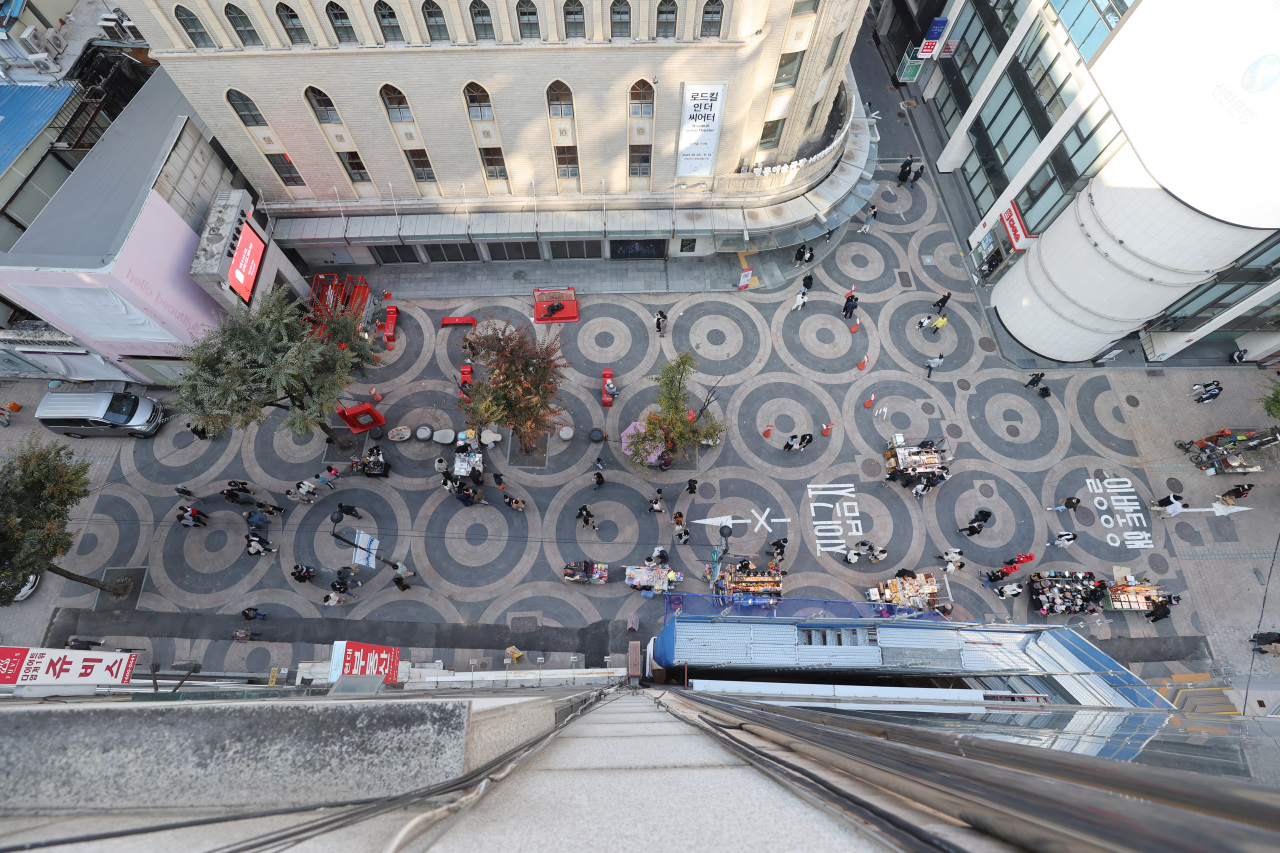
This photo shows a street in Myeongdong, a popular shopping district in Seoul, on Sunday afternoon. (Yonhap)
South Korea on Monday unveiled its road map for a “return to normal,” about a year and nine months since the first case of COVID-19 was confirmed here.
The government COVID-19 response headquarters, comprising several ministries and the Korea Disease Control and Prevention Agency, said social distancing restrictions and other public health precautions will be lifted on a phased basis stretching over a dozen weeks.
The timeline put forth shows Korea will be entering phase one on Nov. 1, and then phase two on Dec. 13 to get to phase three on Jan. 24 next year. In the third and the final phase, all COVID-19 restrictions on businesses and personal interactions will end.
Each phase will last four weeks, with a grace period of up to two weeks. Depending on metrics such as hospital bed availability and intensive care patient counts, moving on to the next phase may be put off.
The headquarters, citing Bank of Korea projections, said maintaining the existing social distancing practices could cost Korea 13 trillion won ($11.12 billion) per month, which is tantamount to a loss of about 8 percent of yearly GDP.
The accrued socioeconomic costs of the pandemic-related restrictions, especially the devastation of small businesses, as well as the progress in vaccination rates and the consequent decline in deaths from COVID-19 provided the rationale for turning the tide, it said.
In the initial phase of Korea’s recovery from the pandemic, which will center on restoring normal operations for businesses, the changes due are as follows.
Regulations impacting businesses will be “minimal,” the headquarters said. Most businesses will no longer be required to close their doors by a certain hour. Restaurants, movie theaters, gyms and other “high-risk” venues that were subject to varying nighttime curfews can stay open 24 hours a day. Nightlife establishments, on the other hand, need to close by midnight.
At these venues considered to pose an “increased risk of contagion,” visitors will be asked to present proof of vaccination or negative PCR test results. Nightlife establishments are the only type of venue where unvaccinated people won’t be allowed even if they are negative and medically exempt from vaccination.
Minors under 18 and people who cannot be vaccinated for medical reasons do not need to provide proof of vaccination or a negative test.
Up to 10 people at a time will be able to meet up without having to show vaccination records or negative test results -- except at food outlets, where unvaccinated people won’t be able to gather in groups as large.
Large celebrations and rallies can entertain up to 100 people regardless of whether they are vaccinated. Among people who are fully vaccinated, as many as 500 can be accommodated.
Mask orders and QR code-based identification will stay for some time, however.
Wearing masks will continue to be mandatory indoors at least through the first and second phases. Letting go of masks may be possible in the last phase, the headquarters hinted.
For contact tracing purposes, people will be asked to scan smartphone-generated QR codes containing information such as resident registration numbers and vaccination status at all public places.
The pursuit of a return normal will proceed as planned unless there emerge “signs of a health care system collapse,” which the headquarters has defined as an 80 percent COVID-19 bed occupancy.
To alleviate the load on hospitals, at-home care, which has been the default arrangement for patients younger than 70 since late September, will be gradually expanded to patients of all ages with mild or no symptoms at the time of diagnosis. Admission to hospitals or other health care facilities will be reserved for patients with severe to critical illness.
Korea Disease Control and Prevention Agency Commissioner Jeong Eun-kyeong said in an address to the public that as the recovery phase of the pandemic unfolds, a rise in patient numbers was expected. Although more than 70 percent of the population is now fully vaccinated, there were some 10 million that have not received a first dose.
Despite all Jeong said now was time for Korea “to tread carefully on the road back to normal.” “COVID-19 could not be eradicated, but we need to find ways to safely coexist,” she said.
By Kim Arin (
arin@heraldcorp.com)






